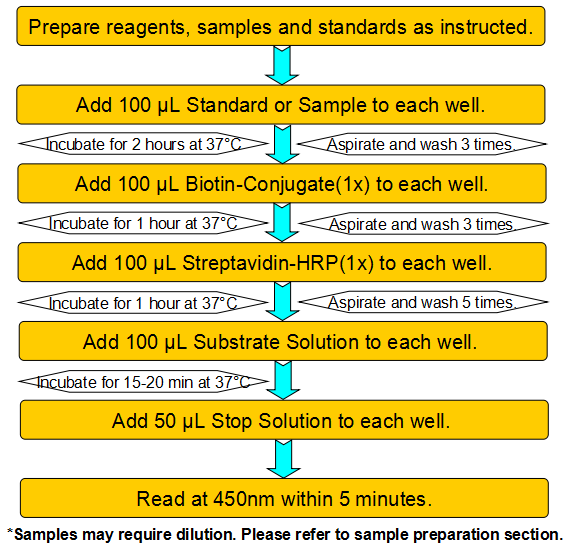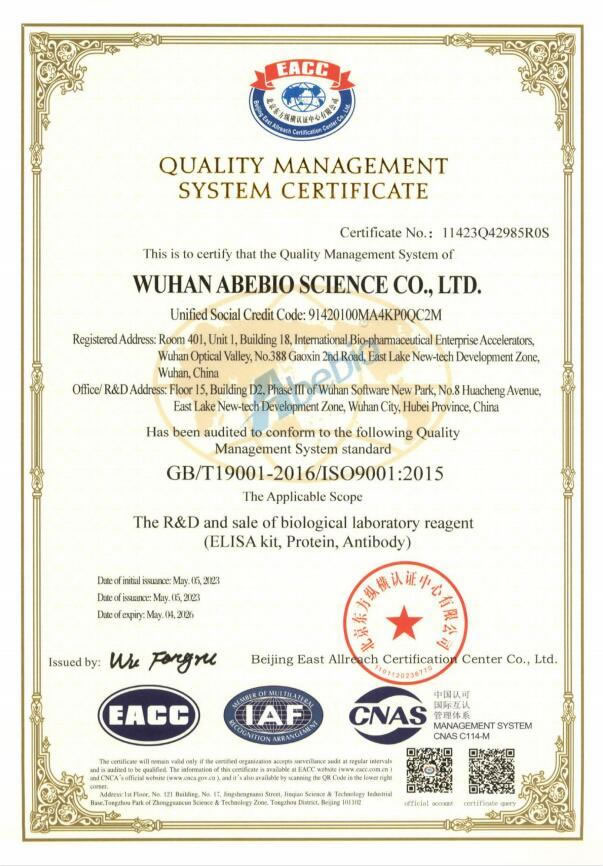Product Details
| Species Reactivity |
Monkey (Simian) |
| UniProt |
N/A |
| Abbreviation |
C1INH |
| Alternative Names |
SERPING1; C1IN; C1-INH; C1NH; HAE1; HAE2; Serpin Peptidase Inhibitor Clade G Member 1; Angioedema Hereditary; C1 Inhibitor; C1 Esterase Inhibitor |
| Range |
7.8-500 ng/mL |
| Sensitivity |
3.9 ng/mL |
| Sample Type |
Serum, Plasma, Other biological fluids |
| Detection Method |
Sandwich |
| Analysis Method |
Quantitive |
| Assay Duration |
1-4.5h |
| Sample Volume |
1-200 μL |
| Detection Wavelengt |
450 nm |
Test principle
This assay employs a two-site sandwich ELISA to quantitate C1INH in samples. An antibody specific for C1INH has been pre-coated onto a microplate. Standards and samples are pipetted into the wells and any C1INH present is bound by the immobilized antibody. After removing any unbound substances, a biotin-conjugated antibody specific for C1INH is added to the wells. After washing, Streptavidin conjugated Horseradish Peroxidase (HRP) is added to the wells. Following a wash to remove any unbound avidin-enzyme reagent, a substrate solution is added to the wells and color develops in proportion to the amount of C1INH bound in the initial step. The color development is stopped and the intensity of the color is measured.
Product Overview
C1-INH is a critically important protein that controls activation of multiple plasma mediator pathways. This protein, a member of the serine protease inhibitor (serpin) group, originally was described as an inhibitor of C1. It binds stoichiometrically to the active sites on both C1r and C1s to form a complex C1-INH-C1r-C1s-C1-INH and thus inhibits activated C1. In addition, C1-INH has been reported to remove the intact C1qrs complex from an activating surface and to inhibit autoactivation of C1. C1-INH is a known inhibitor of kinin generating (kallikrein), fibrinolytic (plasmin), and contact activation (intrinsic) pathway of the coagulation cascade. Recently, it has been shown to be an inhibitor of the mannan-binding lectin pathway of complement activation, inhibiting mannan-binding lectin-associated serine proteases (MASPs) in that pathway.
Components
Reagents |
Quantity |
Reagents |
Quantity |
Assay plate (96 Wells) |
1 |
Instruction manual |
1 |
Standard (lyophilized) |
2 |
Sample Diluent |
1 x 20 mL |
Biotin-Conjugate (concentrate 100 x) |
1 x 120 μL |
Biotin-Conjugate Diluent |
1 x 12 mL |
Streptavidin-HRP (concentrate 100 x) |
1 x 120 μL |
Streptavidin-HRP Diluent |
1 x 12 mL |
Wash Buffer (concentrate 25 x) |
1 x 20 mL |
Substrate Solution |
1 x 10 mL |
Stop Solution |
1 x 6 mL |
Adhesive Films |
4 |
Specificity
This assay has high sensitivity and excellent specificity for detection of Monkey C1INH. No significant cross-reactivity or interference between Monkey C1INH and analogues was observed.
Recovery
Matrices listed below were spiked with certain level of recombinant Monkey C1INH and the recovery rates were calculated by comparing the measured value to the expected amount of Monkey C1INH in samples.
Precision
Intra-assay Precision (Precision within an assay)
Three samples of known concentration were tested twenty times on one plate to assess intra-assay precision.
Inter-assay Precision (Precision between assays)
Three samples of known concentration were tested in forty separate assays to assess inter-assay precision.
CV (%) = SD/meanX100
Intra-Assay: CV<8%
Inter-Assay: CV<12%
Linearity
The linearity of the kit was assayed by testing samples spiked with appropriate concentration of Monkey C1INH and their serial dilutions. The results were demonstrated by the percentage of calculated concentration to the expected.
Stability
The stability of ELISA kit is determined by the loss rate of activity. The loss rate of this kit is less than 5% within the expiration date under appropriate storage condition.
The loss rate was determined by accelerated thermal degradation test. Keep the kit at 37°C for 4 and 7 days, and compare O.D.values of the kit kept at 37°C with that of at recommended temperature. (referring from China Biological Products Standard, which was calculated by the Arrhenius equation. For ELISA kit, 4 days storage at 37°C can be considered as 6 months at 2 - 8°C, which means 7 days at 37°C equaling 12 months at 2 - 8°C).
Sample collection and storage
Serum: Use a serum separator tube (SST) and allow samples to clot for two hours at room temperature or overnight at 2 - 8°C before centrifugation for 15 minutes at 1000 × g. Remove serum and assay immediately or aliquot and store samples at ≤ -20°C. Avoid repeated freeze-thaw cycles.
Plasma: Collect plasma using EDTA, or heparin as an anticoagulant. Centrifuge for 15 minutes at 1000 × g at 2 - 8°C within 30 minutes of collection. Assay immediately or aliquot and store samples at ≤ -20°C. Avoid repeated freeze-thaw cycles.
Other biological fluids: Centrifuge samples for 20 minutes at 1000 × g. Remove particulates and assay immediately or store samples in aliquot at -20°C or -80°C. Avoid repeated freeze/thaw cycles.
Kits storage instructions
Store at 2-8°C. Please refer to Instruction Manual.



